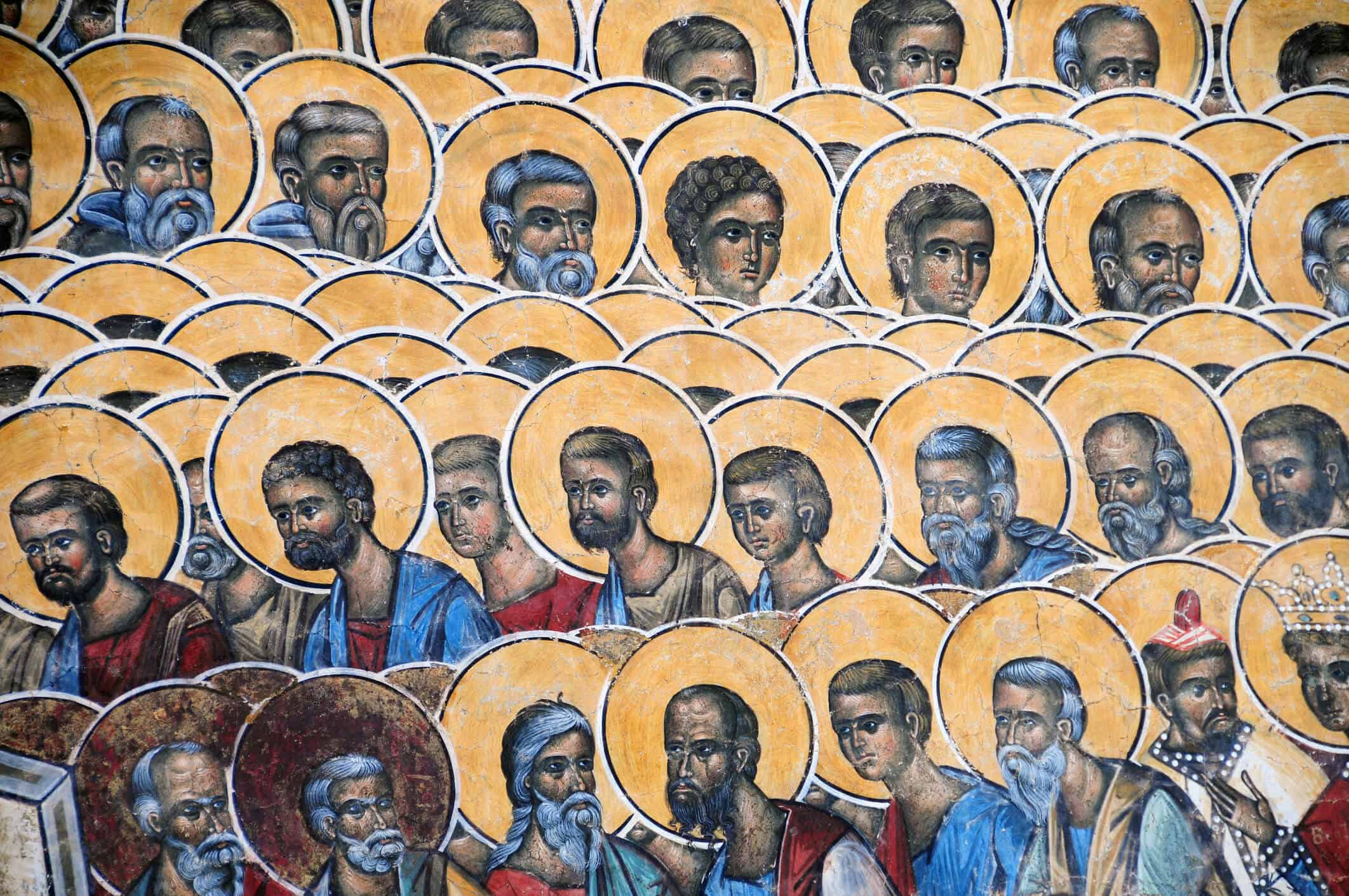June 3
Sts. Charles Lwanga and Companions
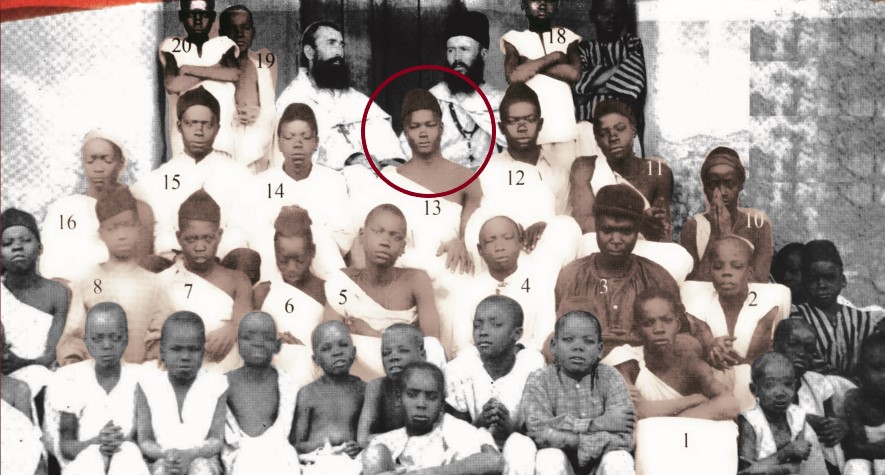
“It is as if you are pouring water on me. Please repent and become a Christian like me.”
Saint Charles Lwanga to his executioner
One of 22 Ugandan Catholic martyrs, Charles Lwanga was one of the young men serving in the court of King Mwanga II in present day Uganda during the 1880’s. Mwanga was a notoriously brutal ruler and pedophile who forced himself on the young men serving as pages and attendants. When the Catholic head page Joseph Mkasa confronted Mwanga over his murder of an Anglican missionary bishop and his companions, he was in turn murdered. The position of head page fell to Charles Lwanga, who requested and received baptism that same day. Charles continued to protect his charges from the violent advances of the king.
When the pages were questioned by the ruler and his court, any who were discovered to be catechumens or baptized Christians were forced to choose between agreeing to the king’s advances or death. Charles and his fellow Catholic pages, aged 13 to 30, were imprisoned; Charles encouraged and sustained them in their decision to remain chaste and hold fast to their faith.
After being marched almost 40 miles to an execution site at Namugongo, they were tortured for a week in an effort to force them to recant. None did. Finally, the young men were wrapped tightly in reed mats and thrown onto a pyre, including Mbaga, the son of the chief executioner. In all 22 Catholic and 23 Anglican young men suffered death during this period rather than give up their faith.
June 5
St. Boniface
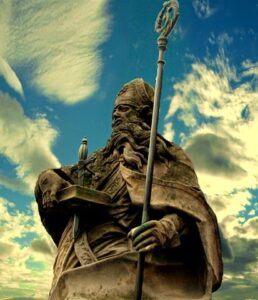
“My children, cease your resistance; Spill no useless blood. The long-expected day is come at last.”
St. Boniface, as he and his companions were martyred
Born in 675 in England, the young man Winfrith was educated at the Benedictine monastery at Exeter, England. He felt a vocation to spread Christianity in Northern Europe, and traveled to Thuringia, in present day Holland, as a missionary; unaware of the fact that the country’s ruler had declared war on Christianity. Returning to England he started planning for his second missionary journey, by journeying first to Rome to gain papal authority for his missionary work. Pope Gregory II was initially skeptical, but eventually backed Winfrith’s mission to Germany; in fact, in his commission, Pope Gregory referred to Winfrith by the name “Boniface” for the first time. Ironically, as it turned out, the day before he received his commission was the feast day of a martyr named Boniface.
Boniface spent three years in Thuringia, the place of his former debacle, working with the famous missionary Willibrord. With that experience to rely upon, he traveled to Rome, where he was consecrated bishop by the Pope, and who instructed him to reform the German Church. Then on to Hesse; in Hesse he had to start from scratch, since it had never been evangelized. To demonstrate the power of Christ over the pagan gods, he cut down a giant sacred oak tree dedicated to Thor. Standing on the six foot trunk, he proclaimed, “How stands your mighty god? My God is stronger than he.” Boniface made the first real inroads in the conversion of the inhabitants.
He journeyed as a missionary to several Northern Europe regions, including a return to Thuringia. He appealed to English monks and nuns for help and they responded enthusiastically over the years. During a final mission to the Frisians, Boniface and 53 companions were massacred while he was preparing converts for confirmation. St. Boniface is known as the apostle of the Germans
June 9
St. Ephrem the Syrian
St. Ephrem was a 4th century teacher and deacon, who argued against the heresy of Arius through his hymns and poetry, in sermon and in song. He was honored as a Doctor of the Church in 1920, and is sometimes called “the Harp of the Spirit”. He is the only Syriac Christian recognized as a Doctor of the Church.
Born in the year 306 in Nisibis, Mesopotamia, perhaps as the son of a pagan priest, he was baptized as a young man and became famous as a teacher in his native city. When the Christian emperor had to cede Nisibis to the Persians, Ephrem fled to Edessa to escape persecution, along with many other Christians. He is credited with attracting great glory to the biblical school there. He was ordained a deacon but declined becoming a priest. Ephrem was said to have avoided presbyteral consecration by feigning madness!
At that time Edessa was a city that was home to a wide range of Christian believers, including heretical sects like the Arians, Marcionites, and Gnostics, as well as Jewish and pagan believers. Ephrem became a staunch defender of orthodox Christianity. He used contemporary philosophy, science, art, and music as tools to uphold the Nicene faith. It is surprising to read that he wrote hymns and poems against the heretics of his day. He would take the popular songs of the heretical groups and using their melodies, compose beautiful hymns embodying orthodox doctrine. Ephrem became one of the first to introduce song into the Church’s public worship as a means of instruction for the faithful. His many hymns have earned him the title “Harp of the Holy Spirit.”
He had a prolific pen, and his writings best illumine his holiness. Although he was not a man of great scholarship, his works reflect deep insight and knowledge of the Scriptures. In writing about the mysteries of humanity’s redemption, Ephrem reveals a realistic and humanly sympathetic spirit and a great devotion to the humanity of Jesus. It is said that his poetic account of the Last Judgment inspired Dante. He wrote over 3 million lines of poetry. Ephrem preferred a simple, austere life, living in a small cave overlooking the city of Edessa. It was here that he died around 373.
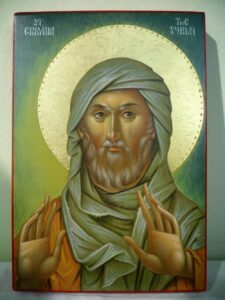
“Forget not the Holy Spirit at the moment of your enlightenment;
St. Ephrem the Syrian
He is ready to mark your soul with His seal….He will give you the heavenly and divine seal which makes the devil tremble;
He will arm you for the fight; He will give you strength.”
June 13
St. Anthony of Padua
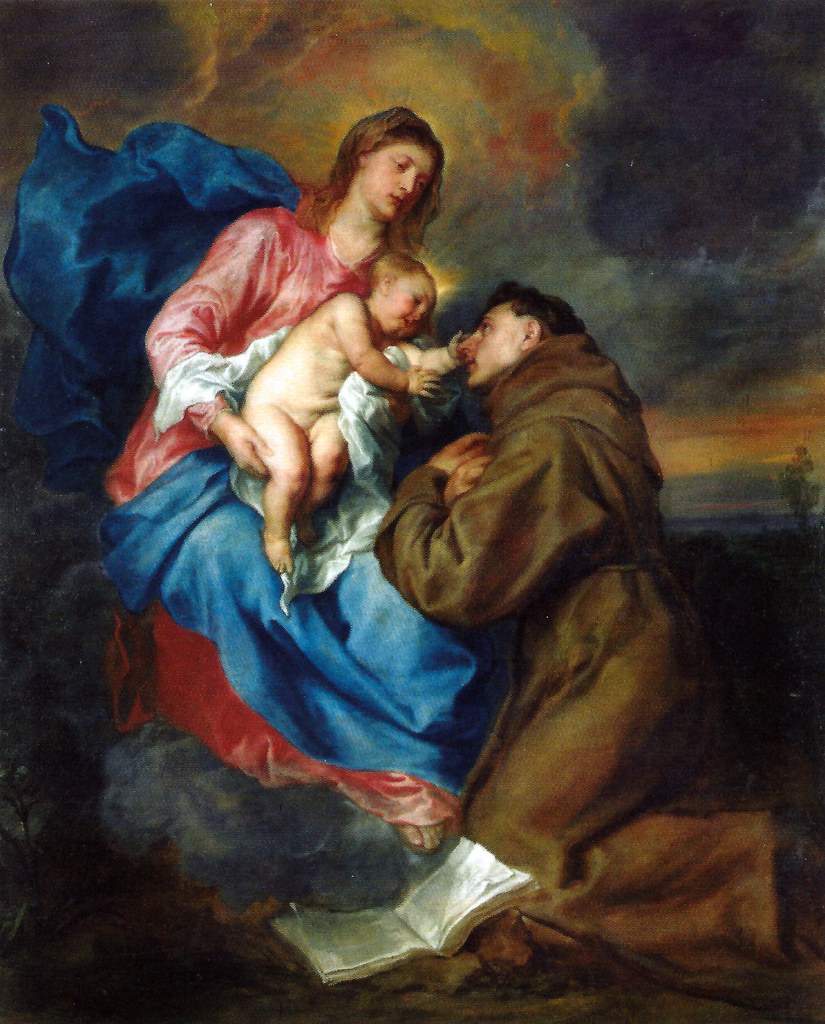
“We are formed by environment and grace, by politics and prayer, by church and conscience. All God’s creatures conspire to teach us as well. We stumble. We stutter. We rise. We are lifted.”
St. Anthony of Padua
Saint Anthony was born Fernando Martins in Lisbon, Portugal. At the age of 15, he decided to join the Augustinians in Lisbon, giving up a future of wealth and power to be a servant of God. Later, Fernando received permission to enter the Franciscan Order, where he took the religious name “Anthony.” His intention was to preach to the Moors in Africa, but when he became ill in Morocco, he was sent home to Italy. His ship was blown off course and landed in Sicily; Anthony went to a small hermitage in Tuscany to recover.
Sometime later, at a mass where no one was prepared to speak, Anthony’s superior asked him to deliver the homily. Hesitantly he accepted the task. His sermon was eloquent and insightful, and astounded those present, who expected an unprepared speech from this unknown friar. News of this reached Francis of Assisi, who recognized him as a great man of prayer and theology. Francis entrusted the studies of his friars to Anthony.
Anthony recorded many of his thoughts and insights in a book of the psalms. When a novice stole the book, Anthony prayed for the return of the missing book. Not only was the book returned, but the novice repented and returned to the order! Even today, he is asked to make intercession for the recovery of lost articles.
Once, when Anthony attempted to preach the Gospel to heretics who would not listen to him, he went out and preached his message to the fish, for the glory of God, the delight of the angels, and the easing of his own heart. When critics saw the fish begin to gather, they realized they should also listen to what Anthony had to say.
After he led the friars in northern Italy for three years, in the spring of 1231, Anthony withdrew to a friary at Camposampiero where he prayed and prepared for death. On June 13, he became very ill and asked to be taken back to Padua, where he died after receiving the last sacraments. He was canonized less than a year later and named a Doctor of the Church in 1946.
June 17
St Albert Chmielowski
Albert Chmielowski was born in Igolomia near Kraków as the eldest of four children in a wealthy family. He initially studied agriculture in order to manage the family estate, but was deeply Involved in politics from his youth. He fought for Polish independence in the 1864 revolt against Czar Alexander III; a Russian grenade killed his horse and wounded his leg so badly that it had to be amputated – without any anesthesia.
Albert had been studying engineering, but when he was exiled because of his rebellion, he discovered a talent for painting, and while in exile, studied art in Warsaw, Munich, and Paris. Returning to Krakow in 1874, he became a well known and well liked artist. But he was a gentle and compassionate soul, and felt called to help those in need. After years of reflection, he understood that this desire was how God was calling him to service and Himself.
In 1880, he began exploring religious life, and in 1887 became a Secular Franciscan, and founding the Brothers of the Third Order of Saint Francis, Servants to the Poor, known as the Albertines or the Gray Brothers (after their rough gray habits). They worked primarily with the homeless, depending completely on alms while serving the needy regardless of age, religion, or politics. He established a community of Albertine sisters, also dedicated to serving the poor and homeless.
Albert died in 1916 on Christmas day, due to stomach cancer. He died in one of the shelters that he had established, maintaining his involvement with the poor even to his death.
Albert preached that the great calamity of our time was that so many refused to see and voluntarily relieve the suffering of their miserable brothers and sisters. The “haves” lived away from the “have-nots” in order to ignore them and leave their care to others. In 1949, Karol Wojtyła, the future Pope John Paul II, wrote a well-received play about Albert; the work was filmed in 1997, released as Brother of Our God. John Paul II later said that he found great spiritual support for his own vocation in the life of the Polish saint whom he saw as an example of leaving behind the world of the arts to make a radical choice in favor of the religious life.
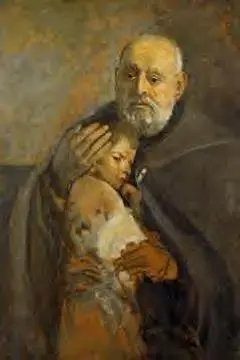
and the Albertine Sisters
“I look at Jesus in His Eucharist. Could His love have provided anything more beautiful? If He is bread, let us too become bread… let us give ourselves.”
St Albert Chmielowski
June 21
St. Aloysius Gonzaga
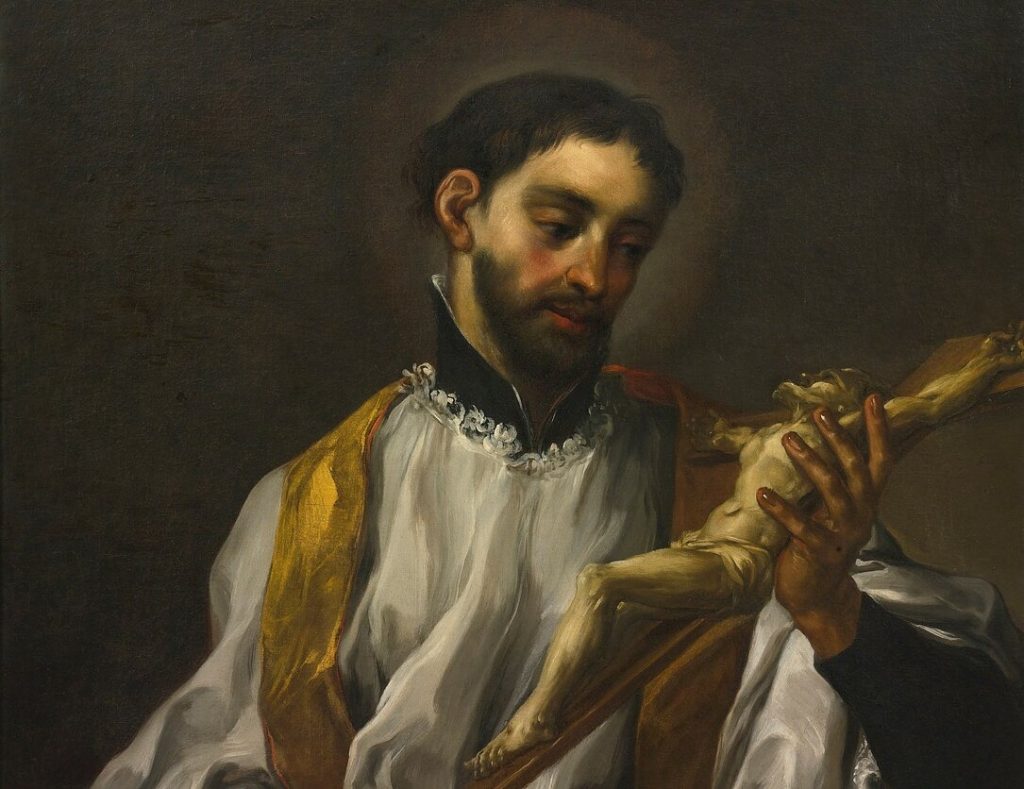
“I am a piece of twisted iron, I entered the religious life to get twisted straight.”
St. Aloysius Gonzaga
St. Aloysius Gonzaga (1568–1591) was born to a noble Italian family, the eldest of seven children, and was destined for the military. When Aloysius was but five, his father, the Marquis of Castiglione, took him to a military camp. Aloysius returned home mimicking the soldier’s rough language, but when his tutor chastised him, he became deeply contrite.
By the age of seven he was reciting the Little Office of the Virgin Mary and the seven penitential psalms daily. By the time he was nine years of age he chose the religious life and made a personal vow of chastity. As a safeguard against sexual temptation he always kept his eyes downcast in the presence of women.
Having read about the Jesuit missionaries, Aloysius decided to join them—a plan his father tried to destroy by sending him on a tour of the northern Italian courts. Although many tried to dissuade him from his chosen vocation, he remained absolutely firm; and at seventeen he was allowed to renounce his inheritance and enter the seminary in order to become a Jesuit priest.
The always-frail Aloysius took on many mortifications, which his spiritual director encouraged him to moderate. Yet Aloysius could not hold himself back when the Jesuits went out to care for the suffering during a plague in Rome. He threw himself into the task of offering physical comfort and spiritual consolation. Eventually, he caught the plague himself. Although he seemed to recover, Aloysius foresaw the end, increasing his prayers. The fever returned, as he had predicted, and he died at the age of twenty-three, before completing his priestly studies.
St. Aloysius was connected with two great figures of the Counter-Reformation: he received his First Holy Communion at the age of twelve from St. Charles Borromeo, and his Last Rites from St. Robert Bellarmine, both of whom served as his spiritual advisers. On the night of his death, St. Mary Magdalene de Pazzi had a vision of him being received into great glory.
June 22
St. Thomas More
Thomas More was born in 1478 in London, the son of a Justice of the King’s Bench. After receiving a first-rate education, Thomas rose to become an esteemed lawyer. His professional success caught the eye of King Henry VIII, who invited him to court. Henry had a deep appreciation for Thomas’ wit and intelligence, and they became personal friends. He appointed him to a series of high posts, finally making him Lord High Chancellor of England.
When Henry sought to divorce his wife and declared himself the head of the English Church, Thomas distanced himself from his friend. He quietly resigned and retired to relative poverty—a blessing, he reassured his wife and children. He embraced a simple life and continued his practice of frequent prayer. But Henry was not satisfied. He wanted Thomas to swear an oath to support him.
When Thomas refused, he was confined to the Tower of London for fifteen months. While there, Thomas wrote many warm letters to his four children. He withstood his daughter Margaret’s frequent pleading that he sign the oath. Thomas was at last tried and found guilty of treason. Four days later, he stepped onto the scaffold, declaring himself “the king’s servant, but God’s first.”
Thomas More was canonized in 1935.
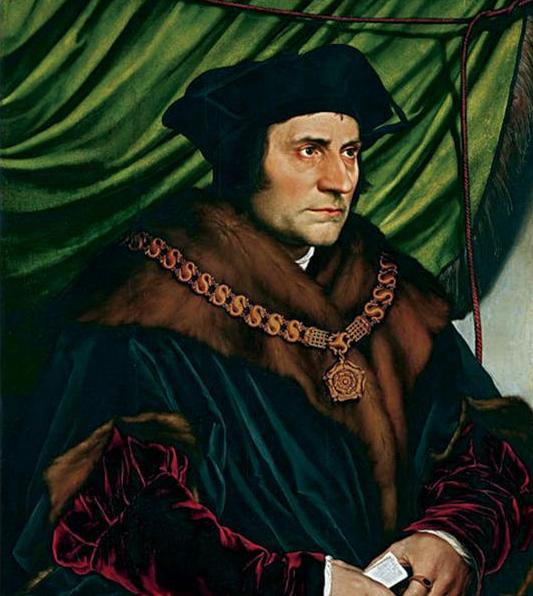
Because the soul has such deep roots in personal and social life and its values run so contrary to modern concerns, caring for the soul may well turn out to be a radical act, a challenge to accepted norms.
St. Thomas More
June 24
Birth of Saint John the Baptist
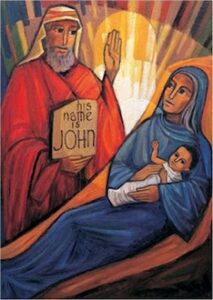
Besides Christ Himself, only two saints’ birthdays are commemorated liturgically: The Virgin Mary’s on September 8, exactly nine months after the Feast of her Immaculate Conception; and Saint John the Baptist’s on June 24, 6 months before Christmas. Jesus himself declared John to be the greatest among those born of women. John was the forerunner of the Messiah, declaring his coming in his public preaching around the river Jordan.
The Gospel of Saint Luke tells us that John was born through the intercession of God to his parents Elizabeth and Zechariah, who were otherwise beyond the age for having children. Zechariah, a priest of the temple, was disbelieving of the Archangel Gabriel who proclaimed that Elizabeth would give birth to a boy they must name John. Zechariah was rendered speechless until the child’s birth. While Elizabeth was pregnant with John, she was visited by Mary, and, recognizing the presence of Jesus in Mary’s womb, John leapt in Elizabeth’s womb.
When John was finally born, Zechariah insisted that he be named John; when he did, his speech was finally restored. A beautiful proclamation poured forth from him in recognition of God’s impending intervention in the lives of the Jewish people. That proclamation, called the Benedictus, is still prayed today as a part of morning prayer in the Liturgy of the Hours.
June 26
St. Josemaria Escriva de Balaguer
Josemaria was the second of six children of a Spanish textile merchant Jose Escriva and his wife Dolores. He entered the seminary at sixteen, was ordained in 1925, and went to Madrid for doctoral studies. Longing to place himself at the service of the Lord, his constant prayer was Ut sit, “that it might be done.” In addition to his pastoral duties, he undertook an apostolate with manual workers, professional people and university students who, by coming into contact with the poor and sick to whom Fr. Josemaria was ministering, learned the practical meaning of charity
And, on October 2, 1928, the Lord answered him. In prayer, he “saw” a new form of life in which Christians in all walks of life would cultivate a deep attachment to Christ while living and working in the world. He called it “the work of God,” Opus Dei. It’s growth in Spain was seriously impeded by the religious persecutions during the Spanish Civil War. After the war, in 1947, Josemaria obtained papal approval for Opus Dei, and it began to spread outside of Spain.
Around this time, Josemaria was diagnosed with diabetes; over ten years, the disease progressed. On April 27, 1954, he received an insulin injection that sent him into anaphylactic shock. Not only did he survive this shock, but he recovered to find that his diabetes was gone. The day had been the feast of Our Lady of Montserrat, and Josemaria, who had prayed often at her shrine in Spain, credited Mary with his cure. In The Forge, he wrote, “If I were a leper my mother would hug me. She would kiss my wounds without fear or hesitation. Well, then, what would the Blessed Virgin Mary do? When we feel we are like lepers, all full of sores, we have to cry out: Mother! And the protection of our Mother will be like a kiss upon our wounds, which obtains our cure.”
Monsignor Escriva died in Rome suddenly in 1975. By the time of his death, Opus Dei had spread to thirty nations on six continents. Today Opus Dei has around 90,000 members, both men and women. 98% are laypeople, most of whom are married.
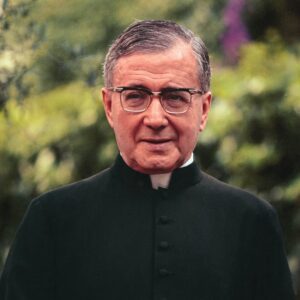
“Prayer is not a question of what you say or feel, but of love. And you love when you try hard to say something to the Lord, even though you might not actually say anything.”
St. Josemaria Escriva
June 30
Solemnity of Sts. Peter and Paul
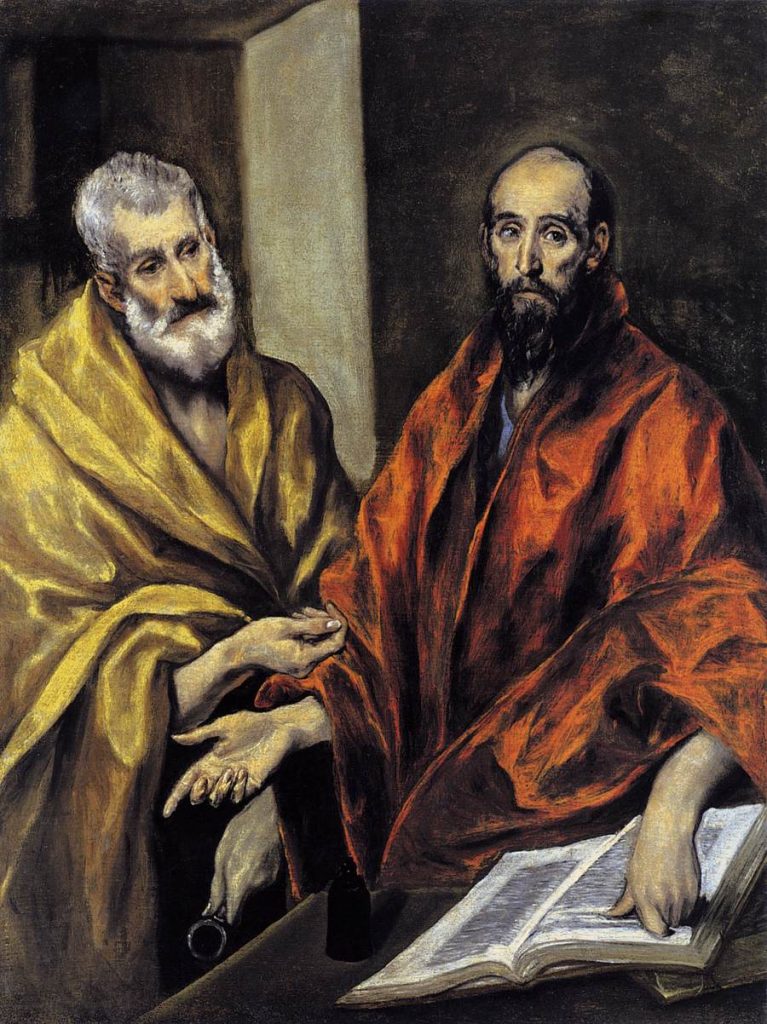
St. Peter is a patron of bakers, shoe makers, masons, net makers, popes, ship builders, locksmiths, and watch makers; and against fevers and foot problems.
The great Saint Irenaeus in the late second century stated that Rome is “the greatest and most ancient Church, founded by the two glorious Apostles, Peter and Paul.” The Catholic Church is large and diversified, in terms of culture, but is one in terms of faith and belief. Rome has long been associated with the Church, in that it witnessed the martyrdom of two of its greatest saints, St. Peter and St. Paul.
Peter, the fisherman. Paul, the tentmaker.
Peter, chosen by Christ to be the first pope. Paul, commissioned by Christ as the Apostle to the Gentiles.
Peter lived as a fisherman on the shores of the Sea of Galilee as a fisherman when he and his brother Andrew were called to follow Christ. He was clearly chosen to be the leader of the apostles, despite the fact that the Gospels unflatteringly portray him as an imperfect and very human person. It was upon him, the first pope, that Jesus chose to found his Church.
Paul was a tentmaker by profession and a ruthless persecutor of Christ’s followers by choice. Converted by the risen Jesus on the road to Damascus, this most Jewish of all men became the instrument by which the message of Jesus Christ was conveyed to the Gentiles.
The Church is founded upon a perfect God and two very different, great, and imperfect men whom God chose—Peter and Paul. Both men met their eternal reward in Rome, and both are buried there: Peter in the necropolis under the main altar of St. Peter’s Basilica; and Paul, under the main altar of the Basilica of St. Paul Outside the Walls. It’s fitting that the Church set aside a day to celebrate these two great saints together.
“Their sound has gone out into all the earth and their words to the ends of the world”
Rom 10:18

